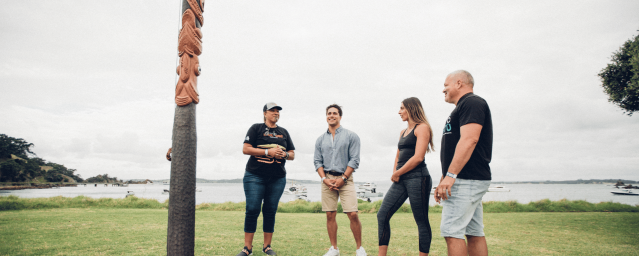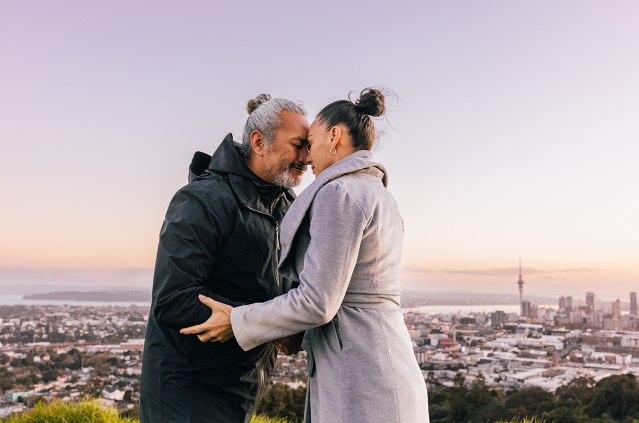KO WHAKAATA TĀMAKI TŌ HONONGA AHUREA
Your cultural connection
Aotearoa New Zealand is proudly multicultural, with over a third of the population born overseas – Auckland being home to the largest Polynesian population in the world.
However, it is the indigenous people or tangata whenua (people of the land) known as Māori who hold mana motuhake (inalienable rights), especially when it comes to connection with the land.

Tuia ki runga
Tuia ki raro
Tuia ki waho
Tuia ki roto
Nō ngā hau e whā o Tāmaki Makaurau
E tautoko ana a Tātaki ki
Tāmaki Mākaurau Herenga Waka
Tāmaki Mākaurau Herenga Tāngata
Haumi-ē hui-ē (Tāiki-ē)
Connect us to those who have gone before us
Connect us to this land we are on
Connect us to the natural environment around us
Connect us internally
to the far corners of our home – Auckland
so that we – Tātaki – shall help our city to be
A place to unite nationalities
A place to unite people
Unite us in readiness for the purpose that we have come together (we are united)
Karakia
These words are known as a karakia or spiritual alignment, acknowledging those who have come before us, as well as our connections and our intent in our work. Karakia are commonly used in te ao Māori (the Māori world) and are part of a wider scope of tikanga (protocol) and tradition when engaging in cultural practices.
Māori people settled the Auckland isthmus around 1350, calling it Tāmaki or Tāmaki Makaurau, meaning "Tāmaki desired by many", in reference to the desirability of its natural resources and geography.
Our past and future
From 1600 to 1750 the Tāmaki tribes terraced the volcanic cones, building pā (fortified villages). At the peak of prosperity in 1750, the population numbered tens of thousands. It was pre-European New Zealand's most wealthy and populous area.
The signing of the declaration of independence in 1835 and the Treaty of Waitangi in 1840, enshrined these rights in law. While the partnership between Māori and Pakehā has often had difficulties, Tātaki Auckland Unlimited and Screen Auckland are committed to upholding honourable and respectful relationships, especially when it comes to the care and protection of the land and people.
Today, Auckland Council recognise 19 mana whenua groups. Many of these groups have overlapping interests in certain areas.
The legal term for Māori groups as they relate to engagement with Auckland Council is ‘Mana Whenua’ (Spiritual and Cultural Authorities of the Land), whereas in conversation, most groups prefer to be referred to as ‘iwi’ (tribes) and ‘hapū’ (sub-tribes).
Screen Auckland’s role
Screen Auckland’s role is to connect film productions to relevant iwi and hapū groups, and advise on protocols, culturally sensitive areas, likely costs and timeframes to receive permission to film on iwi land, as well as the best approach to get the best outcomes, and build meaningful and ongoing relationships.
It is important to note that Screen Auckland’s role, is that of a connector and advisor rather than that of a negotiator when it comes to additional costs and time frames that may arise from cultural assessments and operations carried out by iwi.
Iwi engagement
Iwi engagement is an essential step in the permit process, when it comes to filming on location in Tāmaki Makaurau Auckland.
Some filming applications may be deemed inappropriate for some designated locations, or there may be additional requirements to meet. Therefore early and comprehensive consultation with relevant mana whenua groups is the best way to reduce the risk of unexpected replanning of your shoot.
We strongly recommend consultation with relevant iwi groups before filming begins. We also recommend that production companies and location managers familiarise themselves with the guides and resources available, in particular the mana whenua consultation tool when determining which tribe(s) to consult with.
More information
More information on ngā iwi me ngā hapū ō Tāmaki Makaurau (The indigenous tribes of Auckland) as well as best practice for cultural engagement can be found on the Taki app, here on Google Play and in the Apple App Store.
You can also find a more detailed guide on working with Māori, from the New Zealand Film Commission here.
If you are new to Aotearoa New Zealand, you will find that Māori words are commonplace in many communications. We have listed some frequently used filming and location kupu (words) below – but you can find more in Te Aka Māori Dictionary here.
Using Māori words contributes significantly to building respectful and meaningful relationships – he taonga te reo! (The language is a treasure).
- Glossary
For the naming of roles within the film and television industry, Māori Television has helpfully compiled this glossary.
For commonplace day to day words used in everyday conversation, specifically with regards to locations, Screen Auckland has compiled a list below.
Ara - path
Awa - river
Hapū - sub tribe
Iwi - tribe
Kai - food
Kaitiaki - guardian (cultural or environmental)
Karakia - a prayer or incantation to acknowledge the spiritual energies present
Mahi - work
Mana - prestige or cultural esteem
Mana whenua - group acknowledged by Auckland Council as having special cultural interests in particular locations in the Auckland region
Maunga - mountain
Moana - ocean
Ngahere – forest
Pōwhiri – a larger more formal welcome for larger groups following traditional protocols
Rakau - tree
Rangatahi – youth / young people (colloquial)
Rohe - area
Tikanga – correct set of traditional protocols to adhere to
Urupa - Cemetery
Waka - vehicle
Waahi tapu – sacred place
Whakapapa – ancestral line
Whakatau – a smaller welcome where there is a settling of spiritual energy
Whare - house
Wharepaku - toilet
Whenua - land
